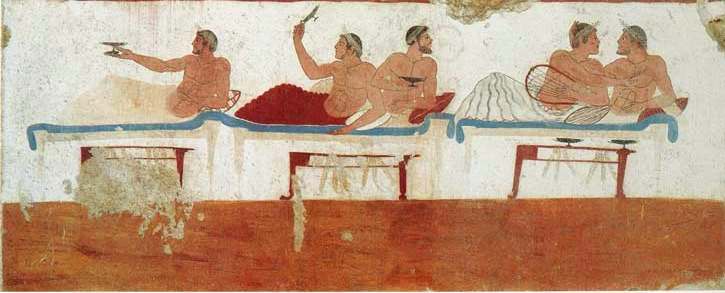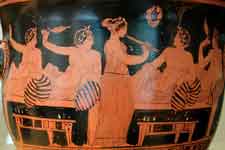.

Symposium, playing the Kottabos (or Cottabus) game.
Cottabus (Gr. κότταβος) was a game of skill for a long time in great vogue at ancient Greek drinking parties, especially in the 4th and 5th centuries BC. To succeed in the aim of the game no small amount of dexterity was required, and unusual ability in the game was rated as high as corresponding excellence in throwing the javelin. Not only was the cottabus the ordinary accompaniment of the festal assembly, but, at least in Sicily, a special building of a circular form was sometimes erected so that the players might be easily arranged round the basin, and follow each other in rapid succession. Like all games in which the element of chance found a place, it was regarded as more or less ominous of the future success of the players, especially in matters of love - and the excitement was sometimes further augmented by some object of value being staked on the event. The game appears to have been of Sicilian origin, but it spread through Greece from Thessaly to Rhodes, and was especially fashionable at Athens. Dionysius, Alcaeus, Anacreon, Pindar, Bacchylides, Aeschylus, Sophocles, Euripides, Aristophanes, and Antiphanes make frequent and familiar allusion to the cottabus - and it appears on vases from the era; but in the writers of the Roman and Alexandrian period such reference as occurs shows that the fashion had died out. In Latin literature it is almost entirely unknown.
Rules of play
The object of the player was to cast a portion of wine left in his drinking cup in such a way that, without breaking bulk in its passage through the air, it should reach a certain object set up as a mark, and there produce a distinct noise by its impact. Both the wine thrown and the noise made were called "latax" (λάταξ). The thrower, in the ordinary form of the game, was expected to retain the recumbent position that was usual at table, and, in flinging the cottabus, to make use of his right hand only.

Symposium scene Nicias Painter MAN
Variations
Various modifications of the original principle of the game were gradually introduced, but for practical purposes we may reckon two varieties:
In the Κότταβος shallow saucers were floated in a basin or mixing-bowl filled with water; the object was to sink the saucers by throwing the wine into them. The competitor who sank the greatest number was considered victorious, and received the prize, which consisted of cakes or sweetmeats.
Κότταβος is not so easy to understand, although there is little doubt as to the apparatus. This consisted of a bronze rod; a small disk or basin, resembling a scale-pan; a larger disk ; and (in most cases) a small bronze figure . The discovery (by Professor Helbig in 1886) of two sets of actual apparatus near Perugia and various representations on vases help to elucidate the somewhat obscure accounts of the method of playing the game contained in the scholia and certain ancient authors who, it must not be forgotten, wrote at a time when the game itself had become obsolete, and cannot therefore be looked to for a trustworthy description of it.
The first specimen of the apparatus found at Perugia resembles a candelabrum on a base, tapering towards the top, with a blunt end, on which the small disk (found near the rod), which has a hole near the edge and is slightly hollow in the middle, could be balanced. At about a third of the height of the rod is a large disk with a hole in the centre through which the rod runs; in a socket at the top is a small bronze figure, with right arm and right leg uplifted. In the second specimen there is no large disk, and the figure is holding up what is apparently a rhyton or drinking-horn.
According to Prof. Helbig in Mititeilungen des deutschen archäologischen Instituts (Römische Abteilung 1886) three games were played with this apparatus:
- In the first, the smaller disk was placed on the top of the rod, and the object of the player was to dislodge it with a cast of the wine, so that it would fall with a clatter on the larger disk below.
- In the second (as in the third) the bronze figure was used; the smaller disk was placed above the figure, upon which it fell when hit, and thence on to the larger disk below.
- In the third, there was no smaller disk; the wine was thrown at the figure, and fell on to the larger disk underneath.
Another supposed variety, in which two scales were balanced in such a manner that the weight of the liquid cast into either scale caused it to dip down and touch the top of an image placed under each, probably had no real existence

Link
Smith, Dictionary of Greek and Roman Antiquities (pp. 366-367).
References
This article incorporates text from the 1911 Encyclopædia Britannica, which is in the public domain.
See also
- C. Sartoris. Das Kottabos-Spiel der alten Griechen (1893) (Said to be the most complete treatise on the subject.)
- A. Higgins. Recent Discoveries of the Apparatus used in playing the Game of Kottabos (Archaeologia, li. 1888)
- "Kottabos" in Daremberg and Saglios Dictionnaire des antiquits
- L. Becq de Fouquibres. Les Jeux des anciens (1873)
| Ancient Greece
Science, Technology , Medicine , Warfare, , Biographies , Life , Cities/Places/Maps , Arts , Literature , Philosophy ,Olympics, Mythology , History , Images Medieval Greece / Byzantine Empire Science, Technology, Arts, , Warfare , Literature, Biographies, Icons, History Modern Greece Cities, Islands, Regions, Fauna/Flora ,Biographies , History , Warfare, Science/Technology, Literature, Music , Arts , Film/Actors , Sport , Fashion --- |
Retrieved from "http://en.wikipedia.org/"
All text is available under the terms of the GNU Free Documentation License

